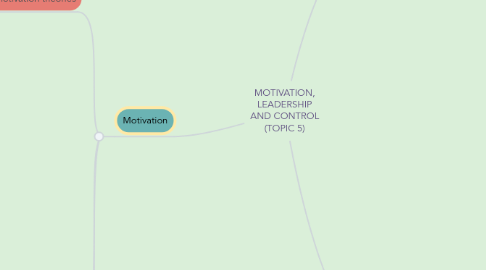
1. Motivation
1.1. The models of employee motivation theories
1.1.1. Classical Theory by Frederick Taylor (1911)
1.1.2. Behaviour Theory by Hawthorne studies (1925)
1.1.3. Contemporary Motivational Theories
1.1.3.1. Maslow's Hierarchy of Needs Model (1954)
1.1.3.1.1. Porpose that people have several different needs that they attempt to satisfy in their work
1.1.3.2. Two Factor Theory by Frederick Herzberg's (1959)
1.1.3.2.1. Hygiene factors
1.1.3.2.2. Motivation factors
1.1.3.3. Expectancy Theory by Victor Vroom (1964)
1.1.3.3.1. Individual Effort
1.1.3.3.2. Individual Performance
1.1.3.3.3. Organizational Rewards
1.1.3.3.4. Personal goals
1.1.3.4. Human Resources Model (Theory X and Theory Y)
1.1.3.4.1. Theory X-theory of motivation holding that people are naturally irresponsible and uncooperate
1.1.3.4.2. Theory Y-theory of motivation holding that people are naturally responsible, self-motivated, and interested in being productive
1.2. Strategies for Enhancing Job Satisfaction and Morale
1.2.1. Reinforcement/behaviour modification
1.2.2. Management by objective
1.2.3. Participate management and empowerment
1.2.4. Job enrichment and job redesign
1.2.5. Modified work schedules
1.2.5.1. Work-Share Programs
1.2.5.2. Flextime Programs
1.2.5.3. Telecommuting Office
1.3. Definition of Motivation
1.3.1. Forces affecting people's behaviour
2. Leadership
2.1. Managerial styles and leadership
2.1.1. Autocratic Style
2.1.1.1. Issue orders
2.1.1.2. Expect them to be followed
2.1.1.3. Rapid decision-making
2.1.2. Democratic Style
2.1.2.1. Ask for input from subordinayes
2.1.2.2. But still retains final authority
2.1.3. Free-Rein Style
2.1.3.1. Manager is advisor to subordinates
2.1.3.2. Subordinates make decisions
2.1.3.3. Fosters creativity
2.2. Definition of leadership
2.2.1. Motivating others to work
2.2.2. Motivating others to work
3. Controlling
3.1. Definition of Controlling
3.1.1. Controlling is the process of measuring performance and taking action to ensure desired result
3.2. Controlling process
3.2.1. Planning
3.2.1.1. Goals
3.2.1.2. Objectives
3.2.1.3. Strategies
3.2.1.4. Plans
3.2.2. Organizing
3.2.2.1. Structure
3.2.2.2. Human Resources Management
3.2.3. Leading
3.2.3.1. Motivation
3.2.3.2. Leadership
3.2.3.3. Communication
3.2.3.4. Individual and Group Behaviour
3.2.4. Controlling
3.2.4.1. Standards
3.2.4.2. Measurements
3.2.4.3. Comparison
3.2.4.4. Actions
3.3. Important of controlling
3.3.1. It facilitates co-ordination
3.3.2. It helps in planning
3.3.3. Protecting the workplace
3.3.4. It helps in planning
3.4. Types of Control
3.4.1. Feedforward Controls
3.4.2. Concurrent Controls
3.4.3. Feedback Controls
